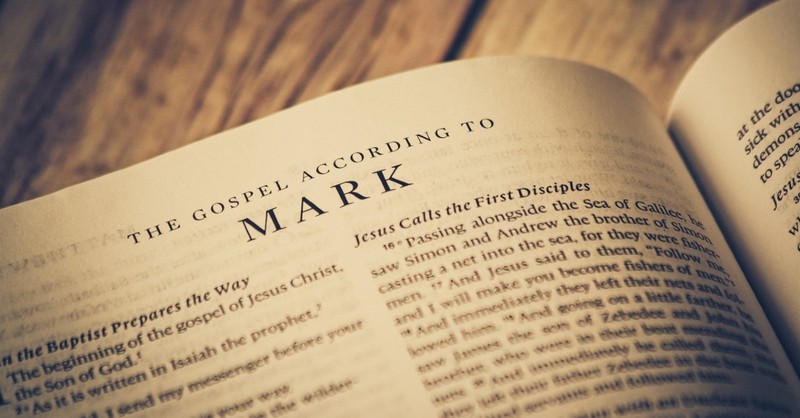Why Did God Give Us Four Gospels?
- Dr. Roger Barrier Preach It, Teach It
- Published Jan 11, 2021

Editor's Note: Dr. Roger Barrier went to be with the Lord on February 16th, 2024. Dr. Barrier's family is honoring his legacy by continuing the ministry of Ask Roger and preachitteachit.org for years to come as they share more than two thousand still-unpublished sermons and Ask Roger articles. All articles authored by Dr. Barrier that are published and republished are done posthumously.
Dear Roger,
I’ve always wondered, why did God give us four Gospels? And why are they different in some places?
Sincerely,
Bob
Dear Bob,
Imagine four people on four different street corners who simultaneously witness the same automobile accident. We know that their descriptions will not match because each one saw from a different perspective.
“We now know that four observers standing on the same corner will not see the same thing. The brain is not like a tape recorder. It observes the high points of what it sees and fills in what it assumes happened between the high points. The brain is quite unreliable for deciphering exactly what happened.” Matt Bradley, Genome
According to the Old Testament law, two or three witnesses were needed to verify an account. Just think; God gave us four—that’s two extra Gospels for good measure!
One witness is not enough to convict anyone accused of any crime or offense they may have committed. A matter must be established by the testimony of two or three witnesses.” (Deuteronomy 19:15)
Next, the word “Gospel” means “Good News.” It’s good news that Jesus died on the cross to forgive our sins.
Yet to all who received him, to those who believe in his name, he gave the right to become children of God. (John 1:12)
The Gospels Are Not …
The Gospels are not biographies. For example, we know basically nothing about the first thirty years of Jesus’ life. The Gospel writers give only enough information about Jesus’ background to prepare us for His death, resurrection, and ascension—and the significance of all three.
The Gospels are in no way objective, and they were never intended to be. They are powerfully, persuasively written to convince people that Jesus Christ is the Savior of the world (John 20:30-31).
The Gospels are not in chronological order. Each gospel writer organized his material under the influence of the Holy Spirit for best presenting the “good news” about Jesus. The Gospel of Matthew is a great example of the use of this literary tool.
God superintended the writing of each Gospel, but He didn’t dictate them. He utilized the personality and individual style of each Gospel writer.
The Gospels Are Divided into Two Groups:
Matthew, Mark, and Luke are called the “Synoptic” Gospels. “Synoptic” means “to see together.” These first three Gospels record the life of Christ from much the same perspective; they look alike and follow one another. John’s Gospel is not at all like any of the other three.
How Mark Wrote the Gospel of Mark
About 60 A.D., Mark decided to write down an account of Jesus’ life and ministry from his perspective.
Mark used Peter’s sermon to Cornelius (Acts 10:37-42) as the outline for his book:
You know what has happened throughout the province of Judea, beginning in Galilee after the baptism that John preached—how God anointed Jesus of Nazareth with the Holy Spirit and power, and how he went around doing good and healing all who were under the power of the devil, because God was with him. We are witnesses of everything he did in the country of the Jews and in Jerusalem. They killed him by hanging him on a cross, but God raised him from the dead on the third day and caused him to be seen. He was not seen by all the people, but by witnesses whom God had already chosen—by us who ate and drank with him after he rose from the dead. He commanded us to preach to the people and to testify that he is the one whom God appointed as judge of the living and the dead.
Papias (130 A.D.) wrote: “Mark is a copy of one of Peter’s sermons.”
Irenaeus (180 A.D.): “Mark transmitted to us in writing the things that Peter preached.”
In summary, Mark presents Jesus Christ as a servant: “The son of man came to serve” (Mark 10:45).
Perhaps that’s why Mark has no birth story. Mark has no genealogy. Who cares about the ancestry of a servant?
The book just begins. Mark uses the word “immediately” often, as the servant moves rapidly from one task to the next. Mark provides little interpretation or teaching. Jesus’ actions and miracles simply speak for themselves.
By the way, Mark puts his signature on the book in Mark 14:51-52. He camouflaged himself in the Garden in order to witness the arrest of Jesus. A Roman soldier grabbed him by his robe, but Mark wiggled out of his robe and ran home naked. Only Mark could have known this story.
How Matthew Wrote the Gospel of Matthew
About five years after Mark wrote his account (about 65 A.D.), Matthew used at least four sources to compose his gospel:
1. He had a copy of the Gospel of Mark.
2. He had in hand a copy of “Q.” Q source is thought to be a collection of the sayings and teachings of Jesus which both Matthew and Luke used in writing their gospels. Since the material in Q is identical to both Luke and Matthew, there is a very good chance that Q existed and was available to them when they wrote their gospels. Nothing from Mark or John is found in Q. Also, we have not discovered the Q sources themselves… yet.
3. Matthew used the birth narratives from Joseph’s side of the family. Matthew alone tells us about wise men, kings, gifts, messenger angels, moving stars, King Herod, worship, and killing babies—the kind of things in which kings are interested.
4. Matthew records his own personal experiences with Jesus (most of which appear in no other gospel).
Matthew was a Roman tax collector who was interested in the power and authority of Rome. He began his gospel with a lengthy genealogy that validated Jesus’ royal lineage for the Jewish leaders. Ernest Hemingway wrote that if he were composing the Gospel of Matthew, he never would’ve started with a boring genealogy. He obviously would begin with the resurrection story to get everyone’s attention.
However, it’s important to note that Matthew’s genealogy includes five women, which was unheard of in those days. He included Tamar, Rahab, Ruth, “Uriah’s wife” Bathsheba, and Mary; all women who followed God in difficult circumstances.
Matthew alone presented five teaching sections describing how to live in the kingdom, spread throughout his gospel.
Finally, Matthew alone included the Great Commission Jesus gave to His followers in the same way that a king would give orders (Matthew 28:19-20) to his subjects;
Therefore go and make disciples of all nations, baptizing them in the name of the Father and of the Son and of the Holy Spirit, and teaching them to obey everything I have commanded you. And surely I am with you always, to the very end of the age.
How Luke Wrote the Gospel of Luke
About five years after Mark wrote Mark and during the time that Matthew wrote Matthew, about 65 A.D., Luke used at least four sources to compose his Gospel:
1. He had in hand a copy of the Gospel of Mark.
2. He had access to the Q source (see above).
3. Luke shares the birth narratives from Mary’s side of the family. Luke alone tells us about shepherds, Mary’s visit to Elizabeth, the visit from the angel Gabriel, Mary’s positive choice to be impregnated by the Holy Spirit, the singing of shepherds and angels, and Mary’s song which she sang after visiting Elizabeth.
4. Research from those who met Jesus personally (Luke is the only gospel writer who never met or saw Jesus.)
Luke was a Gentile physician born in Greece. He had a heart for people in need. The book has a special emphasis on women and children. He tells the birth story from Mary’s side of the family. Luke includes things that she would be interested in—like shepherds, mangers, baby clothes, singing, and angels.
Luke’s genealogy is from the human side of Jesus. It’s obvious that some of the material in Luke was the result of talking to others who knew Jesus personally.
The Good Samaritan parable is unique to Luke, as are the stories of the lost sheep and coin.
Finally, the Gospel of Luke is the first volume of a two-volume work written by Luke known as “Luke and Acts.” He addressed it to a man named “Theophilus,” which means “God Lover” (Luke 1:1-4; Acts 1:1-6).
How John Wrote the Gospel of John
By 95 A.D., most of the original followers of Jesus were dying out. One reason that John wrote his gospel was to get a written record in place before all the eyewitnesses had gone to heaven.
He also wrote to fill in some of the gaps omitted by Matthew, Mark, and Luke.
John utilized essentially no material from the Synoptic Gospels, except for the miracle of the feeding of the 5,000 which is recorded in all four accounts.
More than any other Gospel, John presents Jesus Christ as God. For example, John didn’t include a genealogy because God doesn’t have one.
John also included long discourses and teachings by Jesus which are not included in the Synoptic Gospels. He also left his signature as “the one Jesus loved” (John 13:22-25).
One of the most unique, persuasive elements in the Gospel of John is the eight miraculous signs he selected to prove that Jesus Christ was God.
1. Changing water to wine (John 2)
2. Healing the centurion’s son (John 4)
3. Healing the lame man at the pool (John 5)
4. Walking on the water (John 6)
5. Feeding the 5,000 (John 6)
6. Healing the man born blind (John 9)
7. Raising Lazarus from the dead (John 11)
8. The miraculous catch of fish (John 21)
What Did Jesus Look Like?
Just for fun, I want to share with you the Letter of Lentulus, which was likely written from the Governor of Jerusalem to the Roman Senate to give a physical description of Jesus Christ. It dates back to the second century A.D. and is obviously a forgery. Nevertheless, there’s a good chance that it contains a reflection of Jesus’ real “appearance”:
There has appeared in our times, and there still lives, a man of great power (virtue), called Jesus Christ. The people call him prophet of truth; his disciples, son of God. He raises the dead and heals infirmities. He is a man of medium size; he has a venerable aspect, and his beholders can both fear and love him. His hair is the color of the ripe hazelnut, straight down to the ears, but below the ears wavy and curled, with a bluish and bright reflection, flowing over his shoulders. It is parted in two on the top of the head, after the pattern of the Nazarenes. His brow is smooth and very cheerful with a face without wrinkle or spot, embellished by a slightly reddish complexion. His nose and mouth are faultless. His beard is abundant, of the color of his hair, not long, but divided at the chin. His aspect is simple and mature; his eyes are changeable and bright. He is terrible in his reprimands, sweet and amiable in his admonitions, cheerful without loss of gravity. He was never known to laugh, but often to weep. His stature is straight, his hands and arms beautiful to behold. His conversation is grave, infrequent, and modest. He is the most beautiful among the children of men.
However, St. Augustine has the final word. He wrote in the third century: “We are utterly ignorant of the earthly appearance of Christ.” Personally, I imagine a picture of Him in my mind, but I look forward to seeing Him someday!
Well, Bob, I’ve done my best to offer you a good understanding of why we have four Gospels. I hope you find it helpful.
Love, Roger
Photo credit: ©GettyImages/Javier_Art_Photography

This Ask Roger article features insights from Roger's daughter, Brie Barrier Wetherbee, a sought-after Bible teacher and conference speaker, author, analyst, and Christian theologian.



















